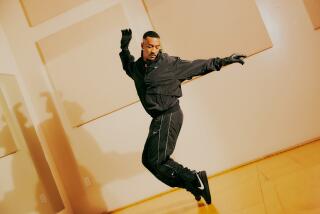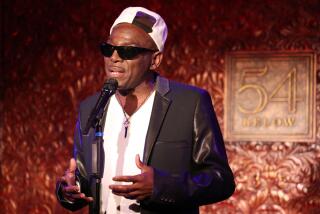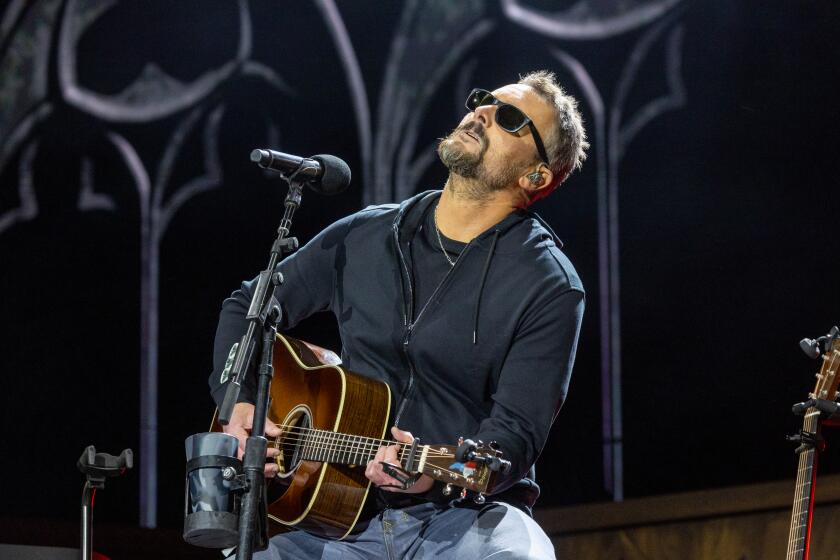Merce Cunningham’s ‘Roaratorio’
In fall 1986, as part of the Brooklyn Academy of Music’s Next Wave Festival, John Cage delivered, in his uniquely spoken-sung fashion, poetic texts he had derived from James Joyce’s readably unreadable comic novel “Finnegans Wake.” Irish musicians played and sang traditional Irish music. An electronic collage of sounds and ambient noises indicated in the “Wake” ran throughout the performance sometimes drowning out all else. Merce Cunningham added invented Irish dances — jigs and reels and the like — abstracted and combined into a Cubist Irish dance canvas.
The din of these sounds and sights, their interactions and assertions of independence, the sheer vastness of materials, suggested the whole world concentrated into that space. Lasting exactly 60 minutes, “Roaratorio” proved my most joyous, exhilarating, uplifting and sensory-intensive hour in the theater.
Premiered in France three years earlier, the work was presented in this form only once after that, the following summer at the Royal Albert Hall as part of the London Proms. Cage died in 1992. Cunningham used individual dances from “Roaratorio” in a series he called “Events,” but he refused to revive the full work, so crucial did he feel was the personal participation of Cage and the individual Irish players. Most of them are also now gone, and when Cunningham died at age 90 last summer, “Roaratorio” seemed no longer even dimly viable.
But Cage loved to quote his inventor father as saying that when someone says something is impossible, that shows you what to do. On June 4, the Merce Cunningham Dance Company — without John or Merce or the singer Joe Heaney or any of the other Irish — will premiere a new realization of “Roaratorio” at the Walt Disney Concert Hall, where, as at the Albert Hall, it will be danced in the round. It will likely be the last time Los Angeles will host the Cunningham company, which after its founder died embarked on a two-year “Legacy Tour.” The company will disband with a farewell performance in New York on New Year’s Eve 2011.
Restoring “Roaratorio” is a crazy idea, but maybe not so impossible or inappropriate as it first seems. I still recall the presence in the performance of Cage, Cunningham and the Irish musicians. The soundscape I know well, since it has long been available on recording. The actual choreography has mostly faded from my memory, however.
But watching the company’s ebullient run-through without music last week at Westbeth, Cunningham’s studio in Greenwich Village, the wonderful feel of “Roaratorio” came rushing back.
Robert Swinston, who was Cunningham’s assistant, was in the performances in the ‘80s. For the revival, he dances Cunningham’s role, along with part of his original role. The rest of the company consists of young dancers, many of whom were not even born when this work was created.
The next day, Patricia Lent, a former Cunningham dancer, who, with Swinston, was responsible for restoring the choreography, explained over the phone what was involved.
Parts of the dance are actually quite simple, she said, and she has long taught them to intermediate dance students as a way of introducing Cunningham technique. But putting the whole shebang together was another story.
First, there is no one “Roaratorio,” a work Cunningham mounted on only five occasions. “Since the dance was not in the regular repertory,” she noted, “every time we put it together was a major event. There were always cast changes and Merce kept redoing the dance. He made a new ending for BAM.”
Nonetheless, with Cunningham’s notebooks and archival films of the performances to fill in gaps from their memory, she and Swinston were able to re-create the mayhem, which sometimes, she said, had two, three or even four things going on at the same time.
There may be instances of simple movement, but the sequences can verge on the impossible to remember. “Merce,” Lent recalled, “loved to produce brain teasers. In terms of the movement, there was no reason it had to be so complicated. But Merce found it interesting to get people thinking onstage.”
As for the music, Cunningham’s feeling that no one could replace Cage or the Irish performers will be honored, which simplifies things greatly. An eight-channel surround-sound installation has been made from the original materials and will be used. However much live performers are missed, this new multitrack recording of all the original performers and the electronic soundscape effectively replicates the extraordinarily obsessive and excessive nature of Cage’s work.
The back story
The title comes from a line in “Wake”: “this longawaited Messiagh of roaratorios.” Asked in 1979 to create a play for West German Radio of Cologne, Cage identified the large number of sounds noted in the text, and places. He reduced those to a workable but still significant 626, the number of pages in the book, half of which he chose to be in Ireland. He then set off to Dublin and with a sound engineer spent a month traveling to 150 locations, sometimes driving 200 miles just to get five seconds of a local dog barking on tape. Scouts in other countries sent back the rest of the sounds.
Cage made a new poetic text of the book, using a technique he invented called “writing through.” For this, he waded through the entire “Wake,” following rules he invented that allowed him to spell out JAMES JOYCE in strings running down the middle of his stanzas. He recorded himself semi-singing that new text as a basis for applying the environmental sounds.
He invited an Irish singer and folk musicians to contribute what they considered suitable material at given points, not reacting to what the others were playing. All of this was a way, Cage said, of letting the book produce its own sound, and by doing so teach him something about music.
Not everyone was enchanted. The recordings were assembled in 1979 at the newly founded electronic studio IRCAM in Paris at the invitation of its director, French composer Pierre Boulez. “What he did with Joyce,” Boulez told me this year, “was really grotesque.”
But it was also inscrutably, buoyantly Irish. Cage had begun reading Joyce’s novel in the 1930s when sections were published in the literary magazine transition. Cage purchased a copy of “Wake” as soon as it came out in 1939, two years before Joyce’s death, but although he kept the book with him and knew certain passages well, he said it took him nearly 40 years to actually read it all the way through.
Joyce’s invented language and stream of consciousness almost defy interpretation (which is why there is so much) and thwart all but the most devoted of readers. But words leap off the page in a magnificent profusion with little effort if you let them, and once Cage became entranced by “Wake,” he never got over the infatuation.
“I hope,” the composer once said, “ ‘Roaratorio’ will act to introduce people to the pleasures of ‘Finnegans Wake’ when it is still on the side of poetry and chaos rather than something analyzed and known to be safe and law-abiding.”
For Cage, the densely packed soundscape of “Roaratorio” captured the spirit of a drunken Joycean celebration, and he always had hoped that Cunningham, with whom he had long collaborated and with whom he lived, would create a dance component. Cunningham was half-Irish, and Cage found a minor character in “Wake” named Merkyn Corningwham.
To get in the spirit, Cunningham said he “decided to think of the company as a sort of family, a large family moving through space … continuing and moving around in a kind of spiral fashion.” He had the dancers start by entering one side of the stage and gradually reaching the opposite side “as though we are going someplace else to start over again or continue in some other way.”
What Lent says she discovered from Cunningham’s notebooks is the density of his layering, which she interprets as having been in response to the many layers of the musical score. One aspect of this is the sense of travel that is created by the use of stools.
“He has this thing with stools,” she says, “that move from stage right to left over the course of the dance. The stools are a kind of baggage. This is a traveling piece, and we are beasts of burden. We’re carrying our stuff.”
But Lent also says the counting was so challenging, that, while dancing, she never could listen to the music. Cage and Cunningham had a famous collaboration in which music and dance were made separately and only brought together at the premiere. “Roaratorio” is unusual in that the music came first, but the sense of separation is still maintained, and the dancers, as usual, rehearse in silence.
Afterward, though, was a different story. “The Irish musicians knew how to have fun,” she says, laughing, also echoing what Cage said about the making of score.
“We went to Ireland and enjoyed every minute of it,” the composer told a German audience in 1979 upon receiving a prize for “Roaratorio.” “Like the rest of the world, it is magnificent, and the people are a pleasure. What distinguishes Ireland is the Guinness, and ‘Guinness is good for you.’ ”
More to Read
The biggest entertainment stories
Get our big stories about Hollywood, film, television, music, arts, culture and more right in your inbox as soon as they publish.
You may occasionally receive promotional content from the Los Angeles Times.







